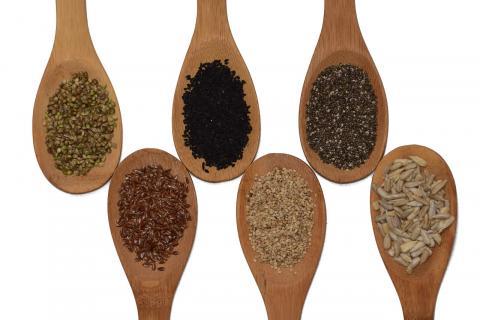
Seed cycling might sound like something better suited to gardening, but is actually a natural method used to support a woman’s menstrual cycle. If you struggle with balancing your hormones (your cramps feel particularly painful, you experience heavy periods, or your cycle feels irregular), adding specifically timed seeds into your diet can improve your menstrual cycle. Not sure how seeds can affect this? Read on to have all of your questions answered.
How does it work?
Seed cycling works thanks to lignans, found in seeds, that can bind to excess estrogen and support its release, thereby balancing estrogen and progesterone hormones in our body, as The Herbal Academy explains. Additionally, fats like omega-3 are utilized during specific phases of the cycle, helping with progesterone production and other hormonal activity. Seed cycling uses four types of seeds, and cycles them accordingly too if you’re in the follicular phase or luteal phase.
More specifically, this is what it looks like:
Days 1-14 (Follicular Phase): Women’s cycles can differ dramatically, so the follicular phase is followed from the beginning of a cycle to ovulation. Every morning, take one tablespoon of pumpkin seeds and one tablespoon of flax seeds.
Days 15-28 (Luteal Phase): This phase follows ovulation, and lasts until menses—again, different in many women. Every morning in this phase, take one tablespoon sunflower seeds and one tablespoon sesame seeds.
Does it matter how the seeds are prepared?
In short, no. You can take the seeds as they are, adding them to coconut yogurt, blending them into smoothies, or enjoying them by the handful. It is important, however, to ensure the seeds are raw and organic to maximize nutrient density. If possible, keep your seeds refrigerated (or you can stick them in the freezer) to deter against rancidity.
How do I start seed cycling if I have irregular periods?
The majority of women have irregular periods, especially when they’ve taken hormonal contraceptives, like the pill or an IUD. In cases like this, you can follow the moon to cycle seeds appropriately. On the first day of the new moon, begin following the follicular phase, which means you’ll be consuming pumpkin seeds and flax seeds. Once the full moon arrives, you should switch to the luteal phase, where you’ll take sunflower seeds and sesame seeds.
I have a hard time digesting seeds. What do I do?
For those who have difficultly digesting seeds, it can be helpful to soak your seeds the night before. Raw, sprouted seeds can also be purchased at some specialty health food stores or online if you’re short on time.
I don’t like eating seeds by themselves. How can I incorporate them into my diet?
Seeds can be ground finely (try using a coffee grinder) and sprinkled on yogurt or salads, or added to oatmeal or smoothies.
I’ve been seed cycling for a week and haven’t noticed a change. What gives?
Natural protocols often take far longer than their synthetic counterparts, so give your body plenty of time to adjust. Most women who begin seed cycling start noticing the effects 3-4 months in, which means roughly 3 to 4 menstruation cycles. However, because seed cycling poses zero risk (unless you suffer from allergies, food sensitivities, or have PCOS, in which case this may not be the right option), you can use it in conjunction with any other protocol.
I’m currently in menopause. Can I still seed cycle?
Yes! Better still, it can help. While your body is no longer producing the high levels of estrogen and progesterone it was making before menopause, seed cycling can still help balance the hormones in your body to reduce certain menopausal symptoms.








